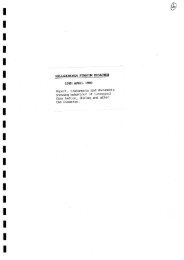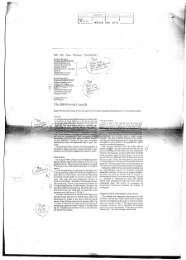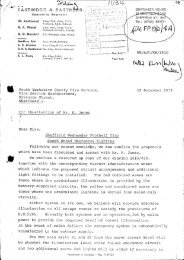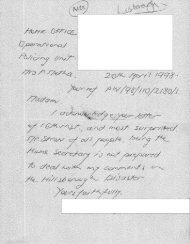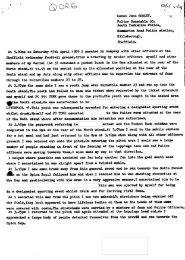DEPARTMENT OF FORENSIC MEDICINE - Hillsborough ...
DEPARTMENT OF FORENSIC MEDICINE - Hillsborough ...
DEPARTMENT OF FORENSIC MEDICINE - Hillsborough ...
Create successful ePaper yourself
Turn your PDF publications into a flip-book with our unique Google optimized e-Paper software.
<strong>DEPARTMENT</strong> <strong>OF</strong> <strong>FORENSIC</strong> <strong>MEDICINE</strong><br />
GUY’S HOSPITAL<br />
(UNIVERSITY <strong>OF</strong> LONDON)<br />
Dr. I.E. WEST, M-B.. OvB.. FR.C.PaUi.. D.MJ.<br />
Dr. R.T. SHEPHERD B.Sc., MJ8.. B.S.. M.R.C.Pa(h.. D.MJ.<br />
Direct Telephone Lme 071 -107 0378 / 071 -,103 1118)<br />
(fix: 071 -103 7292)<br />
UNITED MEDICAL ANT) DENTAL SCHOOLS<br />
GUYS AND ST. THOMAS S HOSPITAL,<br />
LONDON BRIDGE. SE1 9RT<br />
TELEPHONE: 071-955 5000 Ext: 3118/3119<br />
movement. Without the post mortem photographs I am not clear as to<br />
why Dr. Slater feels that there has been intensive blunt compression<br />
of the right side of his face.<br />
5. Kevin Williams - Was examined by Dr. Slater who describes the<br />
external features of classic traumatic asphyxia with cyanosis of the<br />
face extending onto the chest with numerous petechial and larger<br />
haemorrhages on the face and neck. He found bilateral fractures of<br />
the hyoid bone and of the superior horns of the thyroid cartilage<br />
on both sides of the larynx. These appear related to a number of<br />
linear abrasions over the front of his neck and on the undersurfac®<br />
of the chin. There appears to have been local pressure to his neck.<br />
It was possible that when he was crushed in the crowd, the front of<br />
his neck, vas pushed against some rigid structure. It is also<br />
possible that, for instance, he could have been trodden an during<br />
the panic subsequent to the incident occurring.<br />
P . 0 6<br />
*1 do not believe it is possible to say how long consciousness would<br />
" have been retained but he^ certainly would noc have become<br />
unconscious between 3 and 5 seconds of being crushed. Again I would j<br />
not agree with Dr. Slater in estimating how long the deceased would yj<br />
have survived. Although he-has suffered injuiies to the neck these<br />
are by no means invariably fatal and can be seen in those surviving<br />
strangulation and quite striking signs of classic traumatic asphyxia<br />
can be seen in individuals who survive crush incidents because they j/<<br />
are removed frow danger in tiiae to prevent death- As I have already VIJI<br />
indicated he could veil have survived for a considerable period,/tI<br />
well beyond 3.15 pm.<br />
He suffered convulsions as the result of anoxic brain damage.<br />
Whether Mr. Brooder saw convulsions or twitching is irrelevant.<br />
A dead body neither convulses or twitches. Dr. Gompert’s point that<br />
bodies may twitch after brain stem death has taken place is, of<br />
course, correct and to some degree reflects the dilemma over<br />
precisely defining death. One sees it in individuals who are<br />
maintained on a respirator but whose heart is still functioning.<br />
One also may see it during the process of dying as the heart is<br />
stopping and for a very short period after the heart stops. This<br />
phenomenon only occurs for a very short, period after death unless<br />
muscles are electrically stimulated. Twitching movements, however,<br />
suggest that one is much inore likely to be dealing with a live body<br />
than with a dead one.<br />
The evidence of Special Constable Martin is difficult to refute in<br />
some respects. Whilst it is possible for an individual examining a<br />
dead body to mistakenly feel an apparent pulse it is usually<br />
difficult to be mistaken over whether somebody is making breathing




